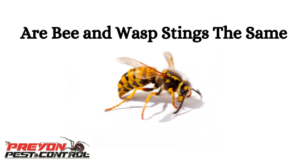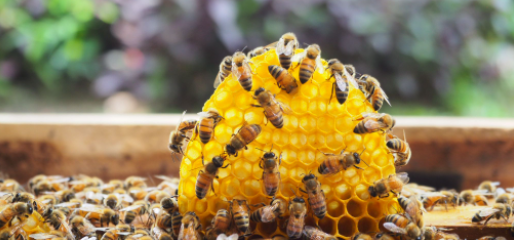A sting is all or nothing for a bee; the bee loses its stinger and injects a large volume of venom — typically around 50 micrograms.
A wasp with a stinger injects 2 to 15 micrograms — but it can do so many times. The venoms are chemically distinct, but the effects are similar. But many people ask are bee and wasp stings the same?

You may be allergic to one type of sting but not another. Both types are complex chemical mixtures, but here’s a rough idea of what’s in them:
- Wasp venom contains enzymes that break down cell membranes as well as neurotransmitters such as acetylcholine and serotonin that cause nerves to fire. They also contain substances that cause the release of histamine, resulting in an intense allergy-like reaction similar to hives.
- Bee stings contain more than half of melittin, a potent toxin that works by activating an enzyme involved in inflammation. Much like wasp venom, it causes the body to release histamine, resulting in a hives-like reaction.
- Both venoms contain hyaluronidase, which breaks down the cell barrier, allowing the venom to spread. Wasps and bees both signal other members of their species after stinging, so get as far away as possible after the first sting.
- Because the venoms are injected, most folk remedies have a little scientific basis, but anything that cools or numbs the wound and distracts the victim’s mind from the pain will help.
Bee stingers should be removed because the venom sac remains attached when the bee flies away and can continue to inject venom for an extended period of time. Antihistamines may help a little, but if you have a severe allergic reaction, call 911 right away. You can also call wasp removal chicago to get rid of wasps.
What Is The Difference Between Bee and Wasp Stings?
- Other possible causes of anaphylaxis
- Cellulitis
What Is the Best Way to Treat Bee and Wasp Stings
Bee stings should be treated by first removing the stinger if the reaction is mild:
- Apply a firm edge, such as a knife or credit card, to the skin near the embedded stinger.
- To remove the stinger, apply constant firm pressure and scrape across the skin’s surface. Using tweezers or fingers, which can accidentally squeeze more venom into the patient, is preferred.
Treatment for the sting:
- Using water or a disinfectant, clean the area.
- Avoid scratching or rubbing.
- Use a cold compress to relieve pain and swelling.
- Analgesia simple
- Apply topical steroid cream or calamine lotion several times per day until symptoms subside.
- If necessary, antihistamines are taken orally
- Oral steroids may be required if the reaction is severe and localized.
Systemic Reaction Treatment
If a bee or wasp sting causes a severe reaction or anaphylaxis, seek immediate medical attention. Advanced Life Support (ALS) protocols should be followed in the hospital.
In the Americas, where the Africanized bee has become endemic, anyone who has received more than 50 stings (‘massive stinging’) should be evaluated for anaphylaxis and toxic envenomation.
Desensitization to Venom Immunotherapy
Gradually increasing doses of insect venom are injected subcutaneously every few weeks for 3–5 years to induce immunological tolerance; continue lifelong in clonal mast cell disorders with a history of severe reactions or very severe anaphylaxis reactions. After discontinuation, protection usually lasts 1–3 years. Honey bee, paper wasp, and yellow jacket European wasp venoms are commercially available.
According to a review, venom immunotherapy significantly reduces the risk of systemic and large local reactions, as well as the risk of anaphylaxis, thereby improving quality of life.
Venom immunotherapy may be advised for:
- Systemic sting reactions in children that are not limited to the skin
- Adults suffering from systemic reactions, including those confined to the skin
- High-risk individuals include beekeepers and patients with clonal mast cell disorders.
- Reduced quality of life as a result of sting reactions
What Happens If You Get Stung By a Bee or a Wasp
The vast majority of bee and wasp sting reactions are localized and resolve in a matter of hours to days. Typically, episodes are rare, and simple preventative measures are all that are required. Sensitization can develop with repeated episodes, as seen in beekeepers and agricultural workers. Following an anaphylactic episode, the risk of subsequent anaphylaxis is less than 50%, and even lower in children.
Preyon Pest Control is well-known for wasp exterminator services in the town. As hornet and wasp stings both are dangerous. For more information, call 708-400-0101.



